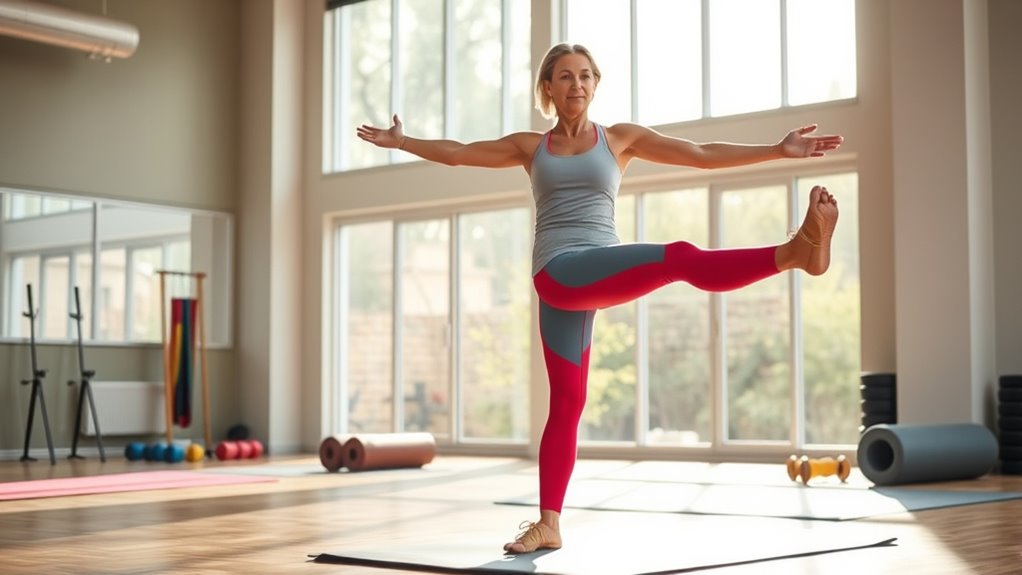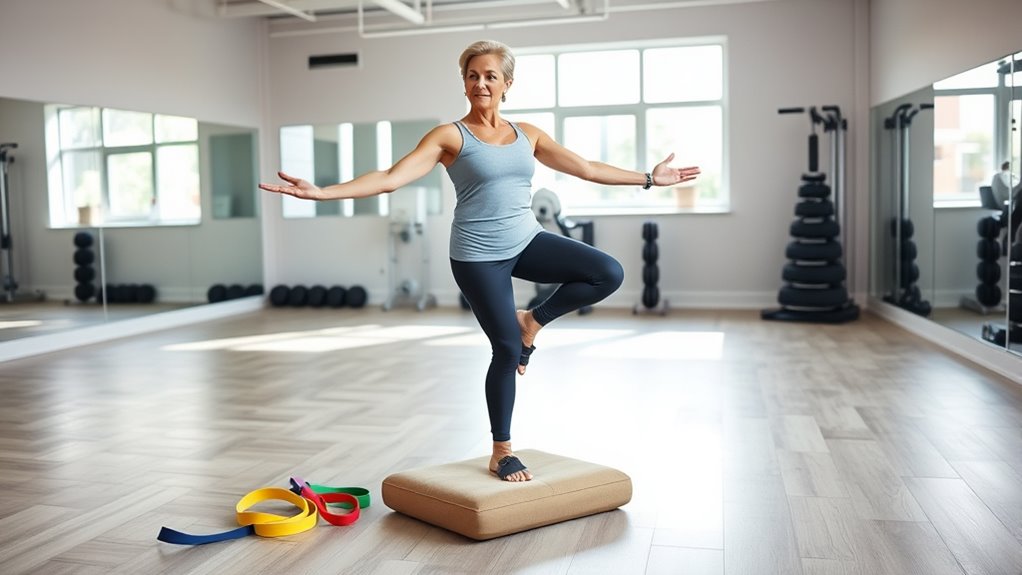Incorporating mobility exercises that focus on dynamic movements, stretching, and balance can considerably improve your stability. Practice activities like single-leg stands, heel-to-toe walks, and gentle joint stretches to enhance flexibility and proprioception. These routines help loosen tight muscles, strengthen core connections, and prevent injuries. Consistent practice builds a resilient, stable body that supports everyday movements and athletic performance. Keep exploring to discover effective techniques that will boost your stability even further.
Key Takeaways
- Incorporate dynamic stretches like leg swings and hip circles to enhance joint mobility and stability.
- Use balance exercises such as single-leg stands and heel-to-toe walks to strengthen stabilizer muscles.
- Integrate core-focused routines like planks and bird dogs to improve overall stability and coordination.
- Combine mobility drills with functional movements to promote joint health and dynamic stability.
- Practice consistent, progressive exercises that challenge proprioception and reinforce neuromuscular control.

Mobility exercises are essential for maintaining and improving your range of motion, helping you move more freely and prevent injuries. When you focus on these exercises, you’re not just enhancing flexibility; you’re also building a foundation for better stability. Balance training is a key component of this process because it challenges your body to stabilize itself during movement. By integrating balance exercises into your routine, you activate your core muscles and improve your coordination, which directly supports overall mobility. Flexibility routines are equally important, as they lengthen tight muscles, increase joint range of motion, and reduce stiffness. Combining these routines with balance training creates a thorough approach to stability that benefits your everyday activities and athletic performance.
Mobility exercises enhance flexibility, stability, and coordination for healthier, more confident movement.
You might find that starting with simple balance exercises, like standing on one leg or walking heel-to-toe along a straight line, can greatly boost your stability. These activities require you to engage your core and fine-tune your proprioception, the sense of your body’s position in space. As you progress, adding dynamic movements such as yoga poses or stability ball exercises can further challenge your balance and enhance muscle coordination. Flexibility routines, like hamstring stretches or hip openers, loosen tight muscles that might limit your range of motion or cause imbalance. When performed regularly, these routines help prevent common injuries linked to muscular imbalances and joint restrictions.
Incorporating mobility exercises into your daily or weekly routine means you’re actively working to strengthen the connection between your muscles and nervous system. This connection is crucial for maintaining stability, especially during complex movements or when recovering from injury. Balance training doesn’t just improve your ability to stand steadily; it also enhances your coordination during dynamic activities, making your movements more precise and controlled. Flexibility routines complement this by ensuring your muscles are supple and responsive, reducing the risk of strains or tears. Together, these elements foster a more resilient and adaptable body, enabling you to move with confidence and ease.
Ultimately, consistency is key. By dedicating time to balance training and flexibility routines, you develop a more stable foundation for all your movements. This not only improves your physical health but also boosts your confidence in performing daily tasks and athletic pursuits. Remember, mobility exercises are about more than just flexibility—they’re about empowering your body to function at its best. The more you commit to these practices, the more natural and effortless your movements become, giving you greater stability and a stronger, more resilient body.
Frequently Asked Questions
How Often Should I Perform Mobility Exercises Weekly?
You should perform mobility exercises about 3 to 5 times weekly for ideal stability. Incorporate them into your workout scheduling to guarantee consistency and allow your body to adapt. Keep your sessions moderate in duration, around 10-15 minutes, and focus on dynamic movements. Adjust frequency based on your progress and how your body responds, but staying regular helps improve stability and flexibility over time.
Can Mobility Exercises Help With Chronic Joint Pain?
Yes, mobility exercises can help with chronic joint pain by enhancing your joint flexibility and reducing stiffness. When you regularly perform targeted movements, you improve blood flow and strengthen the muscles around your joints, which may lead to pain relief. Incorporating these exercises into your routine can make a noticeable difference over time, helping you move more comfortably and with less discomfort, even with ongoing joint issues.
Are Mobility Exercises Safe for Seniors or Beginners?
Did you know that over 60% of seniors experience falls each year? Mobility exercises are generally safe for beginners and seniors when you use age-appropriate modifications. They help improve stability and prevent injuries. Always start slow, listen to your body, and consult a healthcare professional if you have concerns. Proper guidance guarantees you enjoy the benefits safely, reducing the risk of falls and enhancing overall mobility.
What Equipment Is Needed for Effective Mobility Routines?
For effective mobility routines, you’ll need minimal equipment like resistance bands and foam rollers. Resistance bands help enhance flexibility and strength, while foam rollers loosen tight muscles and improve range of motion. Both are affordable, portable, and easy to use, making them perfect for seniors and beginners alike. Incorporate these tools into your routine to boost stability, reduce injury risk, and promote overall mobility with consistent practice.
How Long Before I Notice Improvements in Stability?
You may notice improvements in stability within 4 to 6 weeks of consistent mobility exercises. Track your progress through stability measurement tests, like balance or strength assessments, to see your gains. Exercise duration plays a role; aim for at least 20-30 minutes per session, 3-4 times a week. With dedication, you’ll see your stability improve steadily as your muscles and joints become more resilient.
Conclusion
Incorporating mobility exercises into your routine is like tuning a finely crafted instrument—you’ll notice smoother, more accurate movements. Just like Sarah who struggled with her balance but improved dramatically after a few weeks of consistent practice, you’ll see progress too. Remember, small daily efforts add up—think of it as polishing a gem. Stay committed, and soon your stability will shine brighter than ever, making everyday activities feel effortless and more enjoyable.









